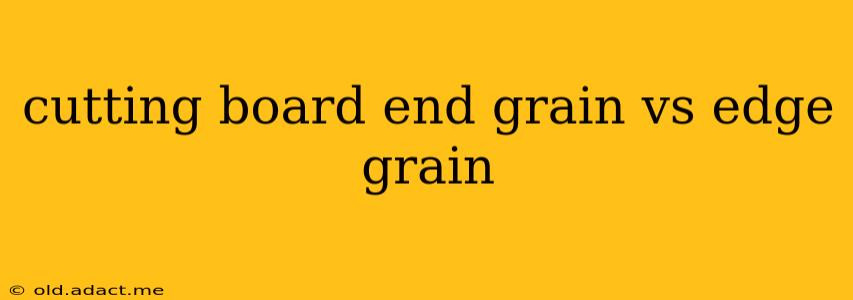Choosing the right cutting board can significantly impact your cooking experience and the longevity of your knives. Two popular types dominate the market: end-grain and edge-grain cutting boards. Understanding their key differences is crucial for making an informed decision. This guide will delve into the pros and cons of each, helping you choose the perfect cutting board for your kitchen.
What is an End Grain Cutting Board?
End-grain cutting boards are constructed with the wood's end grain facing upwards. This means you're cutting across the tightly packed wood fibers, rather than along them. Think of it like this: imagine a tree trunk – end grain is the surface you see when you look directly at the cut end of the trunk.
Pros of End Grain Cutting Boards:
- Exceptional Knife Protection: The dense, tightly packed wood fibers create a self-healing surface, significantly reducing knife dulling and damage. This is their biggest advantage.
- Superior Comfort: The slightly yielding surface provides a more comfortable cutting experience, reducing hand fatigue during prolonged use.
- Easy Cleaning: While requiring more careful drying, the self-healing nature makes cleaning generally easier. Food particles tend to sit on the surface less.
Cons of End Grain Cutting Boards:
- Higher Price: Due to the more complex manufacturing process and the amount of wood required, end-grain cutting boards are typically more expensive.
- More Absorbent: While self-healing, they can absorb more liquids than edge-grain boards. Proper oiling and drying are essential to maintain hygiene and prevent warping.
- Requires More Maintenance: Regular oiling is crucial to prevent dryness and cracking, adding to the overall maintenance.
What is an Edge Grain Cutting Board?
Edge-grain cutting boards feature the wood's long grain running parallel to the cutting surface. This means you're slicing along the wood fibers, creating a smoother, flatter surface. Imagine slicing a tree trunk lengthwise – that's edge grain.
Pros of Edge Grain Cutting Boards:
- More Affordable: Generally less expensive than end-grain boards due to simpler construction and less wood usage.
- Less Absorbent: The wood fibers are more tightly packed, resulting in less liquid absorption compared to end-grain. This makes them easier to clean and less prone to warping.
- Durable & Stable: Edge-grain boards tend to be more resistant to warping and cracking, offering a longer lifespan with proper care.
Cons of Edge Grain Cutting Boards:
- Increased Knife Dullness: Cutting along the grain can dull knives more quickly than cutting on an end-grain board.
- Less Comfortable: The hard, flat surface can be less comfortable to work with for extended periods.
- More Prone to Gouging: Although less absorbent, edge-grain boards are more susceptible to gouges and deep cuts.
Which Cutting Board is Better for Me?
The "better" cutting board depends entirely on your priorities and budget.
- Prioritize knife sharpness and comfort? Choose an end-grain cutting board.
- Prioritize affordability and ease of maintenance? Choose an edge-grain cutting board.
- Need a board for heavy-duty use and don't mind replacing it occasionally? An edge-grain board might suffice.
- Want a long-lasting board that protects your knives, and are willing to invest more? An end-grain board is the superior choice.
What are the different types of wood used for cutting boards?
Many hardwoods are suitable for cutting boards, each with its own characteristics affecting durability, appearance, and cost. Common choices include maple, walnut, cherry, and bamboo (a grass, not a hardwood). Harder woods generally resist wear and tear better. The best wood for you depends on your preferences and budget.
How do I care for my cutting board?
Regardless of whether you choose end-grain or edge-grain, proper care is crucial for extending its life and maintaining hygiene. Regular washing with warm, soapy water is essential. Avoid harsh chemicals and abrasive cleaners. For both types, thorough drying after washing is critical to prevent warping and bacterial growth. End-grain boards will need periodic oiling with a food-safe mineral oil to maintain moisture and prevent cracking.
How long do cutting boards last?
The lifespan of a cutting board varies depending on the type of wood, usage frequency, and care. With proper care, a high-quality end-grain cutting board can last for decades. Edge-grain boards generally have a shorter lifespan, though still many years with diligent maintenance.
By carefully weighing these factors, you can select the cutting board that best suits your culinary needs and budget. Remember, investing in a quality cutting board is an investment in the longevity of your knives and your overall cooking experience.
